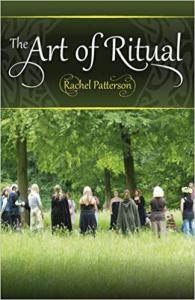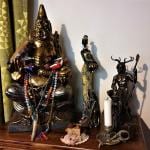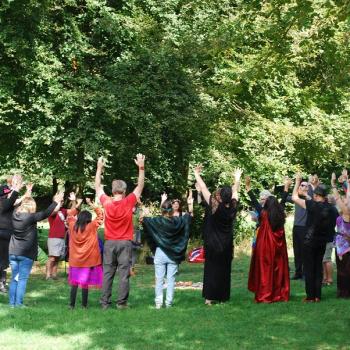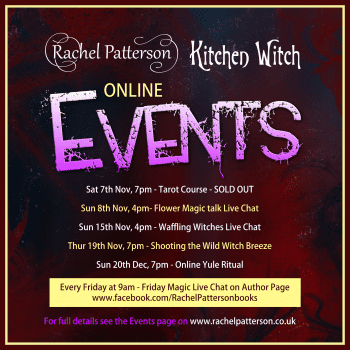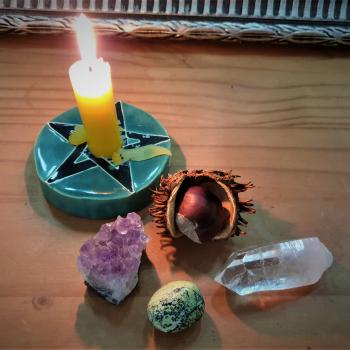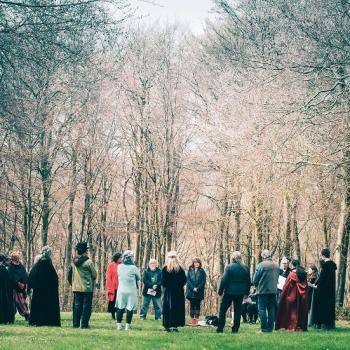
I was asked to give a talk about working with the Art of Ritual, see the video link at the bottom for the replay of the chat.
Here are are few of the important points from the talk:
Ritual – what is it?
Don’t be scared off by the word ‘ritual’ all it means is a set of actions that come together to make a whole.
Rituals are performed by groups but also by solitaries. Rituals can be as simple as daily actions you do to connect with deity right up to ceremonial circles and of course everything in between. We all do our own personal rituals every day even simple rituals such as getting up, cleaning your teeth, showering and having breakfast, it is a set of actions that you put in motion.
My personal inclination is to have a very relaxed ritual using the bare essentials, which obviously includes cake…and to have a little bit of laughter and frivolity in circle because after all the gods have a sense of humour too. My advice is to take what works for you and make it your own. Have a bit of a pick and mix attitude and create something that is unique.
Ritual Basics:
Intent/purpose
You can perform a ritual just to give yourself some sacred time, cast a circle, call the quarters, invoke deity and sit and meditate but rituals are usually set with a theme in mind, it might be to celebrate a sabbat or to work some specific magic or to work with or honour a particular deity.
Clothing & Jewellery
I thought it important to mention here about clothing in particular. One of the statements we often hear is “I can’t go to a ritual I don’t have any ritual clothing”. And our answer is always…”It doesn’t matter what you wear, come in whatever you want to”. As a High Priestess if I am leading a ritual then I do like to make a bit of an effort, I feel it is important in the position that I hold to not only look the part but also dress up to honour deity. In fact it is also a bit of a switch, dressing in specific ritual clothing helps me to tune into the occasion. Cloaks are expensive, they take a long time to make and a lot of material however a coloured throw can be used or a piece of curtain fabric, be inventive. But…if you don’t own a cloak or robes please don’t let it stop you from going to a ritual. However, there are some traditions that do require specific clothing to be worn whether it is a particular colour cloak or for druidic groups it might be druid robes, it is worth asking beforehand.
Sky clad has to be mentioned here, it is a word used for performing a ritual completely stark naked, no clothes, nadda, not a stitch on. There is a camp of thought that says wearing clothes in ritual stops the flow of energy…my thoughts on that are ‘tosh, absolute tosh…’. And anyway I live in the UK…it is way too nippy here to be dancing about nekkid on top of a hill in this weather, I would catch my death of cold…however if it appeals to you go for it, it may be incredibly liberating…just don’t get arrested for indecent behaviour.
As for jewellery I have read on occasion warnings not to wear any bling in ritual that isn’t real silver, gold or precious/semi precious stones because it stops the flow of energy…see my sky clad response above…anyway moving on… If you feel you need to wear a specific piece of jewellery for ritual then do so, if you want to wear your bright pink plastic bubble necklace in ritual do so, follow your intuition.
Sacred Space
This term is thrown about a lot in paganism and although it does mean in part the actual physical space you use for ritual it is soooo much more. Sacred space is within you, around you as you walk, sleep and work – everything is sacred. Having an altar or creating a circle for ritual creates a focal point for that sacred space.
Physical space
You need an area for the ritual, now this might be your living room, your garden, a clearing in your local forest or a sacred site. Wherever you choose to hold the ritual it needs some preparation. If it is indoors make sure you have room, move some furniture if you need to. If it is outside make sure the ground is clear (very embarrassing to be halfway through a ritual and step in dog poop). If you are limited on space just make sure there is enough room to stand or sit without knocking ornaments flying. Whilst it is very special to be able to hold your ritual on a sacred site it is not necessary, the magic, energy and atmosphere created is down to you and those with you – a ritual in your back garden can be just as powerful as one on a sacred site.
Grounding & Centering
Performing a ritual or being part of one should be quite energising, so you need to ground and centre yourself afterwards but I find it is also helpful to do so beforehand as well. They are essentially two different things but often done together and become intertwined.
Procession
I have been a part of many druidic rituals where we don’t start in the circle; we form a line at a designated spot and walk in procession until we meet ‘the gatekeeper’ where we have to ask permission to enter the sacred space. Once the gatekeeper is assured that our intentions are honourable he allows everyone through, we process to the edge of the circle turning and pausing to salute the sun in the East then moving into the circle.
Cast the Circle
Casting a circle puts up a protective barrier around you, it not only keeps out any unwanted negative energy but it also keeps the energy you are raising safely inside the circle until you release it. Casting a circle does however create a place ‘between the worlds’ it is grounded in the physical but also gives you a connection to the spiritual. It can also be a very safe, secure place especially if you need a bit of a spiritual hug, casting a circle and just ‘being’ inside it can be very uplifting.
To cast a circle you can use an athame, a sword, a wand, a staff or just your finger, it is a personal choice. Walk deosil (clockwise) around the circle with your arm outstretched, visualise a bright white light coming from your arm and creating a circle. You can go further with this and make the circle come up and over you in a dome shape and even under you to form a complete bubble. You can also add colours to the visualisation too. You can chant as you cast the circle.
You walk completely around the circle until you come back to where you started, if it is a small circle and you want to use a longer chant you can walk the circle three times, six or nine times.
The circle is usually held in place with visualization as a circle of energy but you can mark it in the physical realm as well. Besoms end to end look quite dramatic but cords also work well or circles of flower petals or leaves but that only works when it isn’t windy! Crystals or pebbles can also be placed around the circle or a good ole fashioned ring of salt (but no salt on the earth please!).
Calling in the quarters
Calling in the elements, calling the quarters, calling the Guardians of the Watchtowers, calling the Elementals – so many names! But essentially we are calling upon the four elements from the four directions to join us in ritual and to lend their power, energy and protection.
The elements are Earth, Air, Fire and Water. They are associated with the four compass directions, North, East, South and West.
The Guardians, sometimes called Guardians of the Watchtowers are the Guardians of the elements. They too share the characteristics of the elements they are associated with. They are not Gods but they are otherworldly.
Each element is then called in turn until all four have been called upon.
Playing with Pentagrams
Often used in Wiccan and ceremonial rituals the pentagram – the five pointed star (pentacle is the five pointed star with a circle around the edge) is drawn in the air at each direction – invoking to bring in the element and banishing to release it.
Invite Deity
Invoking/Evoking
Two very confusing terms invoking and evoking – so what is the difference? To be honest in our coven we often just refer to it as ‘calling in’.
Invocation and evocation are often used interchangeably and both words are apparently derived from the Latin word ‘vocare’ which means ‘to call forth’. Both words mean to summon something non human. But is there a difference? Evocation is used to call an entity forth but in such a way that the practitioner is not linked to them, you invite deity/spirit to join you but you still have control. With invocation the practitioner becomes a vessel, inviting the entity to come forth into them, giving control over to the deity/spirit; basically you invite them into your body/head.
Why do we invite deity?
Usually deity is invited to join a ritual, which ones to invite is again, personal choice. Some groups may only work with specific deities whatever ritual they are performing, some will work with deities specific to the sabbat, some will call upon an all encompassing deity and just invite “The Lord and Lady” to join the rite. If you don’t work with deity you could just call upon Mother Earth and Father Sky, or you don’t have to include deity in your ritual at all.
Why invite deity? Well there are many reasons; we want to honour them, we would like them to witness the ritual, we would like them to enjoy the ritual, we ask for their wisdom, guidance and protection, we would like them to receive our offerings, we would like them to add their energy to our workings and to give us their blessings.
How do you call them?
So you are ready to send out the party invites to the Lord and Lady, what do you do now? You know that I am going to say it’s up to you and personal choice right? However there are traditional ways of doing so. Whichever way you end up doing it always be respectful. A bellow of “oi you lot get over here” will either be ignored or you will pay for it.
Usually the male and female are invited separately. Invite them using their name, their title and say something about their reputation and the specific characteristics they bring with them, basically flatter them. Each invite is usually finished with ‘Hail and welcome’.
Raising energy
Connecting with the energies of your ritual space for me is a must. When I am working in my house or garden I already have that connection, a kind of umbilical cord attached because it is my home and is full with my own energy and all the residue of magic that I have worked there. However when I am outside in a field, a forest or another place I like to connect with the energy of that place before I work a ritual. Close your eyes and put out your mental feelers…see what energy you can pick up. If the space has trees, plants or buildings then try and connect spiritually with them. Once you have connected with that energy source it really helps when you need to raise the energy required for your ritual purpose.
Raising energy might be done by dancing, singing, chanting, playing drums. You can do whatever works best for you. In a group you can raise amazing energy by walking deosil (clockwise) around the circle banging drums or chanting.
Cone of power
Cone of power is a term used for the energy raised in ritual. Basically once you create the energy you increase it until it comes to a peak, once it does you release it and send it out into the universe to do whatever you have asked of it. It is called a cone of power because that is the shape it forms as it is rising. The power starts slowly and builds gradually until the pressure is intense, then you release it.
The working
The part in your ritual when you do what you set it all up for, it might be working a spell, doing some healing, making an amulet or medicine pouch, psychic or spirit work, consecrating and charging tools or crystals or to connect with a deity in meditation. But it might also be just to celebrate the sabbat or the season or work with a particular moon phase.
Offerings
I always think it is nice to give an offering when in ritual, it may just be in the form of leaving some wine and crumbs on the ground for the animals or as a thank you to Mother Earth but you can also make specific offerings or blessings after your ritual working, it is only good manners.
The Feast
Feasting in the form of breaking bread or cake to share is done in a lot of group rituals; it is symbolic of the male and female energies as well as being good for grounding your energies. Usually some of the wine and cake is put onto the ground as an offering to the God and Goddess that have joined you in ritual. Quite often everyone will drink from the same cup, which is passed around person to person. When the drink and food is passed around the term “may you never hunger” or “may you never thirst” is often stated on offering the food or drink the recipient then answers with “Blessed Be”.
Thank Deity
It is very important to thank deity for joining you in ritual; it is after all only good manners to do so. Thank them for their presence, for lending their energy to the ritual, for their support and guidance and bid them farewell. Technically if we invoked or evoked deity at the start now we must work a devocation or sending away/off or as we affectionately refer to it in our coven “bugger offs”. It is a way of releasing the energies that have joined you in ritual, just remember to be respectful and polite, you are thanking them and saying goodbye not dismissing them as if they were of no consequence.
Often the words ‘Hail and farewell’ are used but also ‘Farewell and blessed be’.
Release the elements/quarters
And then you must thank the elements and bid them on their way. If you have called in Elementals or Guardians it is important to thank them properly and send them on their way, you don’t want them hanging around after ritual as they might cause some mischief!
Releasing the quarters is done in the reverse order to that used to invite them. You turn and face the direction you wish to say farewell to, thank them for their presence and bid them on their way.
Close the circle
This is done in a similar way to the casting but you walk widdershins (anti clockwise) around the circle ‘undoing’ the circle that you cast. Visualise the light dissipating and dissolving away.
Don’t forget to ground and also if you are outside please make sure to check you haven’t left any rubbish behind…
Having a laugh
I have attended rituals where I was required to keep a very straight face and be extremely serious, I struggle with that…a lot. It actually makes the ritual very uncomfortable and un-enjoyable for me, but that’s just my personal opinion. When we write and organise our open rituals we make a lot of effort to get them right, but on the day it doesn’t always work out perfectly, we are human after all.
People make mistakes, the weather likes to make an appearance and all sorts of other outside influences happen…oh and my wicked sense of humour really does get in the way. And of course when you work with the mischievous crowd that I do who like to put totally unpronounceable deity names in the script it doesn’t help.
Scripts
I have worked rituals without a script and I have worked impromptu on the spot rituals in the middle of nowhere with no tools or pre planning but as I have a brain like a sieve I prefer to work with a planned outline and a script, especially if I am leading an open ritual as it helps the whole event to run more smoothly. Most of the rituals I have attended the people leading have had scripts or notes of some sort, so it is OK to use them no one will frown upon you for not having remembered all 15 pages of words…it also helps for those people calling quarters that are a bit nervous, they definitely prefer to have something to read out rather than having to make it up on the spot or remember it all. But as I am sure my lot will tell you…I have a habit of going ‘off script’ anyway…
A quick at a glance guide
Cleanse yourself and the ritual space
Cast a circle
Call the quarters
Invite deity
Raising energy
Spell work
Offerings
Feasting/drink
Thanking deity
Releasing the quarters
Closing the circle
Grounding
Video
Details taken from The Art of Ritual by Rachel Patterson

